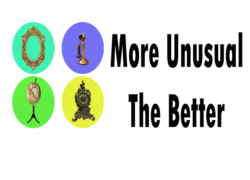Hi and welcome to our Show and Tell. We are showing off some of our fun items that we collected throughout the years. If you see something of interest and are in the USA please contact us. Then we can possibly list and reserve the item you’re interested in at our Etsy store for purchase. For pickup only items we can list and reserve the item at our Ebay store. We are not selling items through this website, it is for Show and Tell purposes only. Thank You!
Seen similar called Salvador Dali Lincoln in Dalivision Lens Ocular. Obliviously no print included. If you have the print and missing the monocle here you go. I don’t see much of a difference looking through but not sure how this is supposed to work.
Measures 3″ long counting handle, outside diameter is 3″ and just plastic has little over 1″ diameter. Weight in original box is 5 1/2 oz. Box has signature in velvet but wearing off from mag rubbing it.
All in all mag is in good condition with light scuffs consistent with age and would look nicer once detailed. Plastic lens is solid in its frame. Found a great write up on Dali Print from the great Wikipedia at bottom of page.
Guessing made early 1980’s. Cool Old Dali Magnifying Glass!!
Please check pictures for description and condition.
Lincoln in Dalivision was primarily published by Levine & Levine in New York in 1977. All editions were signed and numbered. Total production was 1240 “lithographs” in the following editions:
1 – 350 on Arches paper [Distributed by Martin Lawrence Limited Editions, Van Nuys, California, i.e. American Edition]
E1/350 – E350/350 on Arches paper [European Edition]
G1/125 – G125/125 (Publisher Grafos Verlag, Vaduz, Germany)
EA1/75 – EA75/75 on Japon paper [épreuve d’artiste, i.e. Artist’s Print]
AP1/75 – AP75/75 on Japon paper [Artist’s Print]
HC 65 [hors de commerce, i.e. not for sale] – 65 numbered 1/65-65/65 and used mainly for promotional purposes
I/CC – CC/CC on Arches paper
The prints were originally sold at a price of $750[6] and a small viewing optic lens in a blue case was included with the purchase. While viewing photomosaics by squinting the eyes is common today, the optic piece was included to help viewers see the Lincoln illusion from close range.
Due to the extensive counterfeiting and forgeries of Dalí’s signature, Lincoln in Dalivision, expert authentication is usually required to confirm the authenticity of this work. Many experts who can typically authenticate various works via pictures and measurements only, require viewing Lincoln in Dalivision in person before they will authenticate the piece. Frank Hunter of the Dalí Archives requires that he views this work in person before providing a statement of authenticity.
For a “print” released in a rather large quantity of 1240, Lincoln in Dalivision is a surprisingly rare work to come up for auction at major auction houses. Artnet.com shows only a handful of Lincoln in Dalivision sales by auction houses over the past decade.
Respected galleries, including The Salvador Dalí Gallery[11] (California) do list Lincoln in Dalivision in their inventory from time to time. Prices for authenticated works are often listed at prices ranging from $10,000 to $15,000 (per a search of publicly displayed prices on gallery websites completed in 2012). Those with authentication by Albert Field or Frank Hunter appear to carry a slight premium in pricing to other pieces deemed authentic by galleries or other authentication experts.
Lincoln in Dalivision is often referred to as a “print” or “lithograph.” However, neither of these are technically correct, as these terms have specific meanings when referring to original works of art that are created in limited editions. Lincoln in Dalivision is truly a mixed media artwork. It is technically a photolith with original etched remarque (Torrents) and embossing. While the photolith is from the painting, the etched remarque and embossing makes Lincoln in Dalivision an original Dalí. Additionally, the signature of Dalí and the numbering of the limited editions also establishes these works as originals. Lincoln in Dalivision is listed in Albert Field’s The Official Catalog of Graphic Works of Salvador Dalí – authorized by Dalí as an original work[3] and is viewed as such by galleries worldwide.








